The Most Amazing Archaeological Treasures of Ancient Origins in 2023

This year’s archaeological discoveries have presented a wide journey through time and across diverse cultures. This all too brief listing brings you our choice of the most astonishing archaeological treasures found, each shedding new light on our understanding of the ancient world. From the depths of Japan’s kofun burial mounds, where a gigantic sword and mirror hint at lost rituals of demon slaying, to the fields of Denmark, where the oldest inscription of Odin rewrites Norse mythology, these findings span continents and epochs.
We explore the enigmatic 7,000-year-old figurine found in an Italian cave, revealing insights into prehistoric society, and marvel at the exceptionally preserved Bronze Age sword unearthed in Bavaria, still shining after three millennia. The discovery of a medieval skeleton with a prosthetic hand in Germany offers a glimpse into early medical innovations, while a Viking burial site unexpectedly revealed during a home remodeling in Norway reminds us of the treasures that lie hidden beneath our feet.
The narrative takes us to Spain, where the remnants of 7,300-year-old Neolithic cabins have been discovered, and to Britain, where a gold coin stamped with the name ‘Esunertos’ suggests the existence of a previously unknown Iron Age king. In Norway, a massive Viking longhouse is uncovered, while in Germany, archaeologists find what might be the legendary meeting hall of King Hinz.
The article culminates with the discovery of Europe’s oldest stilted village in Lake Ohrid, protected by defensive spikes, and an awe-inspiring find in Zambia, where the world’s oldest wooden structure, half a million years old, challenges our perceptions of ancient human ingenuity.
Each of these discoveries not only provides a fascinating snapshot of the past but also enriches our understanding of the complex tapestry of human history.
1.Giant 7-Foot Sword and Mirror for Demon Slaying found in Japan Tomb
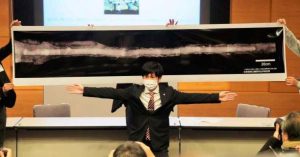
An X-ray showing the relative size of the giant sword found in the Japanese tomb. Archaeological Institute of Kashihara in Nara Prefecture. (Archaeological Institute of Kashihara in Nara Prefecture)
Researchers in Japan were excavating an ancient kofun burial mound when they found an enormous shield-shaped bronze mirror and a giant 7-foot iron sword, the largest that have ever been discovered on the Island.
On January 25th, researchers from the Nara Municipal Buried Cultural Properties Research Center and the Nara prefectural Archaeological Institute of Kashihara announced “unprecedented and exciting” new discoveries.
Prof. Seigo Wada, director of the Hyogo Prefectural Museum of Archaeology, who advised on the excavation, told ASAHI that a team was excavating Japan’s largest round ‘kofun’ burial mound – the Tomio-Maruyama – that was created in the second half of the fourth century AD. Buried in clay at the very center of the ancient tomb, and placed over the deceased’s body, the very unusual giant sword and mirror were recovered.
2. Oldest Inscription of ‘Odin’ Resets Beliefs About Norse Mythology

The medallion bearing the earliest known mention of the Norse god Odin. (Arnold Mikkelsen/ Denmark National Museum)
Archaeologists in Denmark celebrated the discovery of the oldest inscription mentioning the god Odin.
This story begins with the 2021 discovery of a 5th century collection of Norse treasures at Jelling, Denmark, known as the Vindelev hoard. Housed at the National Museum of Denmark in Copenhagen, and containing 22 gold objects weighing around 800 grams (31.32 oz), the Vindelev hoard includes “bracteates” (decorated gold discs) from the Migration Period of northern Europe (400 AD -550 AD), pendants made from Roman coins from the reign of Constantine (306 AD – 337 AD), and rare gold jewelry with ornate granulation design.
Until now, the oldest inscription mentioning the Norse God Odin was identified on a brooch found in Nordendorf, southern Germany, dated to the late 500s. But according to a report in The Washington Post, the latest find on one of the gold discs, demonstrates that the Danes worshipped the god Odin “150 years before previous assumptions”.
3. Enigmatic 7,000-year-old Figurine Found In Italian Cave Shocks Archaeologists
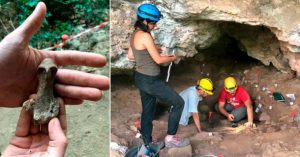
Left; Female figurine found at Battifratta Cave. Right; archaeologists investigating at the cave. (Sapienza University of Rome)
When archaeologists in Italy were exploring the spectacular Battifratta Cave, they did not expect to unearth “a rare” clay female figurine. And neither were they ready for the dating of the piece, which determined the artifact was created some 7,000 years ago!
The Battifratta Cave is a geological wonder located near Poggio Nativo in Sabina, Italy. Deep within a labyrinth of underground chambers and tunnels, adorned with stalactites and stalagmites, a team of archaeological explorers from the Department of Ancient Sciences of Sapienza discovered the ancient doll during their last excavation campaign.
Deemed “unique” in this region, the timeworn female doll informs us about prehistoric society, and she tells stories about ancient rituals and journeys in the afterlife.
4. Exceptionally Preserved “Still Shining” Bronze Age Sword Unearthed in Bavaria

Perfectly preserved Bronze Age sword found in Nördlingen, Germany. (Dr. Woidich/Bavarian State Office for the Preservation of Monuments)
So well preserved “it almost still shines” is what archaeologists termed the incredible find of a 3,000-year-old Bronze Age sword found in the town of Nördlingen, Bavaria in Germany. This fortuitous discovery came to light during the excavation of a burial site containing the remains of a man, woman, and child. As of now, it is unclear whether the three individuals were related or interred in close succession.
3,000-years-old, and still sharp, the sword’s excellent state of preservation has been a joy to behold for the archaeologists. Crafted from bronze, the weapon has an exquisite ornate octagonal hilt. This has acquired a greenish patina over time due to the oxidation of the copper present in the bronze alloy, according to a press statement from Bavarian State Office for Monument Protection.
5. Archaeologists Unearth a Medieval Skeleton with a Prosthetic Hand

The recovered prosthetic hand encased in sediment. Sections of gauze can be seen over some of the fingers. (Bavarian State Office for Monument Preservation)
In an extraordinary archaeological discovery in Freising, Germany, experts unearthed a medieval skeleton equipped with an iron prosthetic hand. The burial, dated to the 15th century, offers compelling evidence of early prosthetic technology and medical innovation.
This find was announced by the Bavarian State Office for Monument Preservation during excavation works near the Church of St George. Carbon dating suggests the man, aged between 30 to 50, lived and died sometime between 1450 and 1620. This period in European history witnessed a surge in the evolution of prosthetics, driven in part by the need to aid injured soldiers returning from numerous conflicts.
6. Viking Burial, Sword, and Treasure Unearthed During Home Remodeling Excavation

Anne and Oddbjørn Holum Heiland have discovered a Viking age burial with weaponry and jewelry from about 1200 years ago during a home renovation. (Joakim Wintervoll/Science Norway)
Little did Oddbjørn Holum Heiland know what he would find when he embarked on a Friday night project, commencing excavation work behind his 1740 Setesdalshouse alongside his wife, Anne. To cut a long story short, the oblong top of a gravestone and the iron hilt of a sword, both related to the Viking Age, were discovered! The full significance of the discovery? A stunning Viking burial site that was completely unexplored.
Their plan was to extend the house, creating additional space in the rear. Speaking to Science in Norway over the phone from Setesdal in Southern Norway, Heiland mentioned, “I initially intended to do just a small amount of digging on the slope behind the house, to create some distance between the house and the surrounding land.” But what a can of worms was opened!
7. Remains of 7,300-Year-Old Neolithic Cabins Discovered in Spain!
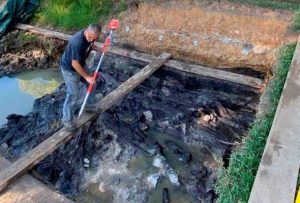
Preserved 7,300-year-old cabins discovered at La Draga Neolithic site in Catalonia, Spain. (Banyoles City Council/IPHES)
Remarkable findings were unearthed in the Neolithic site of La Draga de Banyoles. Excavation work revealed the well-preserved remnants of ancient wooden cabins, shedding light on the lifestyles of farming communities that once settled around L’Estany approximately 7,300 years ago.
La Draga is an Early Neolithic lakeshore site located in Banyoles in Catalonia, Spain, and it is the only prehistoric lake site known on the Iberian Peninsula. It has undergone several excavations around the site since 1990, when it was discovered during construction work for the 1992 Olympics which took place in Barcelona.
From an archaeological standpoint, La Draga stands out due to the exceptional preservation of waterlogged organic materials—such as bones, wood, fibers, textiles, seeds, leaves, and mushrooms—unearthed during excavations. These findings have provided invaluable insights into the ancient environment and societal dynamics of the area.
8. A New Iron Age King in Britain? Gold Coin Found Stamped with the Name ‘Esunertos’
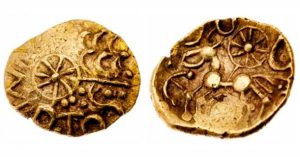
50 BC coin bearing the name Esunertos, a previously unknown Iron Age king. (Spinks Auctions)
Britain’s history may have undergone a significant addition, thanks to the remarkable discovery of a coin bearing the name of a forgotten Iron Age ruler. The coin was unearthed by a metal detectorist in a Hampshire field and carries the inscription ‘Esunertos.’ Experts are speculating that Esunertos may have reigned as a king from the formidable Danebury Fort, and this discovery was heralded as “one of the outstanding discoveries of recent decades.”
Initially, the gold coin was expected to fetch around £4,000 ($5000) at auction. However, it exceeded all expectations by setting a new record at Spinks Auction, selling for a staggering £20,400 ($25,500), reports the Daily Mail.
The coin was found by Lewis Fudge, a metal detectorist who received permission to search a farmer’s field in March this year. Lewis Fudge expressed his elation, stating:
“I am over the moon. If it were not for people in the auction room, I would have jumped around. The collectors I spoke to are gobsmacked. I’m so glad I did not take them up on their private offers before the auction. To think my find has generated its own Wikipedia page is incredible.”
9. Remarkably Massive Viking Longhouse Discovered in Norway

The excavation site at Sem where the large Viking Longhouse has been detected. (Frank Rødberg / County Municipality)
While excavating near the ruins of a 17th century royal estate near the village of Sem in the Eiker district of southeastern Norway, archaeologists unearthed dozens of ancient postholes spread around the faint but unmistakable outline of a Viking longhouse. The architectural structure would have been of tremendous size. Early indications suggest it was probably constructed during the Viking Age, which in Norway lasted from approximately 800 AD to the year 1066.
Postholes were a standard feature of longhouses, regardless of when they might have been built. Heavy wooden posts were needed to support the walls and roofs of these massive construction projects and the posts had to be firmly anchored in the ground. But the placement of the postholes at the newly discovered Viking longhouse is curious and unique, since they were only set up to support the walls.
“The proportions [of the house] are very different,” said archaeologist Christian Løchsen Rødsrud, the leader of the most recent summer excavations in Sem, in an interview with the online journal Science Norway. “In typical prehistoric buildings, the roof is supported by load-bearing posts placed inside the building. In the building at Sem, it seems that the walls support the roof. There are nine meters between the two walls. This is a large span, even in modern construction.”
Outside the outline formed by the first set of postholes, about 11 feet (3.5 meters) away, there were more postholes dug in straight lines. According to the Norwegian archaeologists, these would have supported separate roofing material that covered passageways running along the outside of the main structure. Given the distance between the outer and inner postholes, the archaeologists think the outer posts may have been slanted inward, bracing the outer walls to keep them from bowing under the weight of the structure’s roof.
10. Colossal 3,000-Year-Old Monument Found in Germany May Be King Hinz Meeting Hall
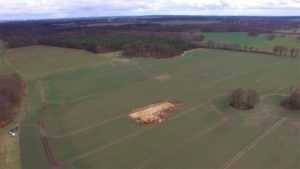
The site of the suspected meeting hall of King Hinz, near Brandenburg, Germany. (Universität Göttingen / Sem. UFG)
In the historically rich soil of Brandenburg, Germany, archaeologists unearthed a colossal Bronze Age building, thought to be the fabled meeting hall of King Hinz, a legendary figure purported to be interred in a golden coffin. The Brandenburg State Office for Monument Preservation confirmed the finding of the hall near the royal grave at Seddin, raising speculation and excitement about its connection to the enigmatic ruler.
Spiegel reported that the discovery of the hall, measuring an impressive 31 by 10 meters (102 by 33 feet), was announced by the state archaeologist Franz Schopper as a “spectacular find.” The excavation, led by Immo Heske from Georg-August University of Göttingen, began in March and reached completion by fall. This structure is a rare architectural gem from the Nordic Bronze Age, dating back nearly 3,000 years, with only two others known in the area spanning from Denmark to southern Germany.
Researchers were captivated by the hall’s dimensions, suggesting it served as a palatial residence. The construction techniques speak volumes about the era’s craftsmanship, with walls of wooden planks, wattle, daub, and clay plaster, topped with a thatched roof. Inside, a central fireplace and an unearthed miniature vessel, likely used in rituals, add to the hall’s aura of mystery and historical importance.
11. Oldest Stilted Village in Europe Found Underwater Behind Defensive Spikes
A team of underwater excavators diving in Lake Ohrid, between Macedonia and Albania, have discovered an ancient, stilted village protected by 100,000 defensive wooden spikes. Built around 8,000-years-ago, this is potentially the oldest stilted village ever discovered in Europe.
Lake Ohrid is situated in the mountainous border of North Macedonia and Albania and its depths hold remarkable archaeological significance spanning over 8 millennia. Now, scientists have uncovered what they think might be one of “Europe’s earliest sedentary communities,” and it was heavily defended.
A report on PHYS.org explains the team of archaeologists believe the Albanian shore of Lake Ohrid was the location of a settlement of stilt houses. It is estimated that between 200 to 500 people inhabited the settlement at any given time, and that it was built between 6,000 and 5,800 BC. If this dating is accurate, then the site represents the oldest lakeside village ever discovered in Europe.
Professor Albert Hafner, an archaeologist from Switzerland’s University of Bern, told AFP that his team of Swiss and Albanian archaeologists spent the past four years excavating at Lin, on the Albanian side of Lake Ohrid. He said the village is “several hundred years older than previously known lake-dwelling sites in the Mediterranean and Alpine regions.” In conclusion, Hafner said this suggests the site is “the oldest” of its type in Europe.
12.World’s Oldest Wooden Structure Found in Zambia – It’s Half a Million Years Old!
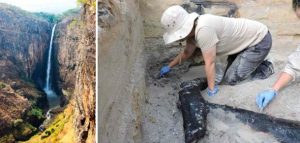
Left; Kalambo Falls, Zambia where the oldest wooden structure was found. Right: the excavation team uncovering the ancient wood. (Left; Professor Geoff Duller/Nature, Right; Professor Larry Barham/Nature)
At the Kalambo Falls archaeological site in northeastern Zambia, archaeologists recovered specimens of ancient wood in the form of logs that had been preserved in waterlogged sand next to the Kalambo River for nearly a half-a-million years—or for 476,000 years, to be more exact. While the discoverers weren’t sure what they had found, a new study by archaeologists from the University of Liverpool and Aberystwyth University in the United Kingdom revealed that the logs were intentionally cut and shaped to be used as building materials. Using a new dating technology known as luminescence, the archaeologists were able to confirm the astonishing age of these incredibly ancient artifacts.
There were many other finds that Ancient Origins covered this year, and you can peruse them for yourself here. We look forward to bringing you the news of many more such finds in 2024.